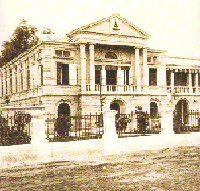วันที่นำเข้าข้อมูล 29 Jul 2020
วันที่ปรับปรุงข้อมูล 30 Nov 2022
A History of Saranrom Palace
Saranrom Palace lies to the east of the Grand Palace. It was built towards the end of the reign of King Rama IV. After the death of King Pinklao in A.D. 1866. King Rama IV decided to give the throne to the Crown Prince who later became King Chulalongkorn, and planned to retire to this palace to live in retirement as advisor on state affairs.
Things turned out otherwise; King Mongkut died in A.D. 1868 King Rama V gave Saranrom Palace to his eldest younger brother, Prince Kroma Phra Chakrabaddibongse. Later King Chulalongkorn let another younger brother, Prince Kroma Phraya Bhanubandh Wongseworadej stay here. Afterwards this palace became the Ministry of Foreign Affairs, and state guests were received here.

First Office for Foreign Affairs
Until 1885, the residence of the Senabodi had been used as Office of Krom Tha. Upon assuming his new post, Krommuen Devawongse Varopakarn submitted a request to the King for an office of his own, as separate from his residence. The request was granted and royal permission given to use Saranrom Palace as the first separate Office for Foreign Affairs. Another significant change was also made, the appointment and general supervision of Thai diplomatic missions abroad, hitherto entrusted to the Prince in his capacity as Secretary-General to the King, were transferred with him to the Krom Tha Office.
Seven years later, in the complete government reform of 1892 resulting in the creation of twelve ministries, based on western standards, the Krom Tha Office became a full-fledged Ministry of Foreign Affairs both in fact and in name. Its judiciary functions and its administrative control of the seaboard provinces were respectively transferred to the Ministries of Justice and Interior. But the position of the head of the Ministry of Foreign Affairs continued to bear the name of Senabodi until the adoption of a constitutional regime in 1932 when it was changed to Rattamontri (Councilor of State) and control of foreign policy no longer rested ultimately with the King but with the executive and legislative branches of the Government.
Saranrom Palace was used by the Ministry of Foreign Affairs for two years. In 1887 it was moved to Sala Lukkhun Nai for three days, to a theatre which then stood in front of Sala Sahathai for one day, and then to the Rajvallop Building. It stayed there until 1926, with an interruption of one year in 1900 when it was temporarily transferred to Kasetradhikarn Building to permit a thorough repair of the former site. In 1926, the Ministry of Foreign Affairs was moved back to Saranrom Palace, where it has remained to this day.
Office Hours : Monday - Friday, 08.30 - 16.30
(Except public and offcial holidays)![]()
This website had been designed to be as accessible as possible to all and is certified by the WCAG 2.0 standard (Level AA)
** ![]() Best viewed with Chrome Version 76 up **
Best viewed with Chrome Version 76 up **
Home
Thailand and ASEAN
Media Center
Ministry of Foreign Affairs
Foreign Policy
Information for Visitors to Thailand
Consular Services
Thailand Now
Diplomatic Corps
Ministry of Foreign Affairs Sri Ayudhya Road, Bangkok 10400 Thailand Tel. 0-2203-5000 Thailand.
